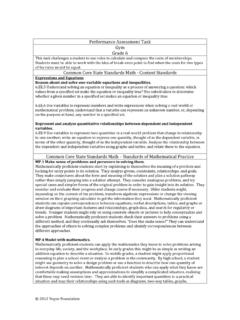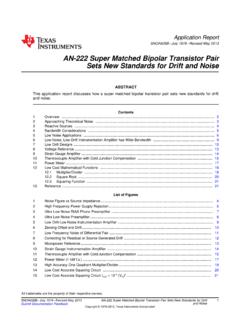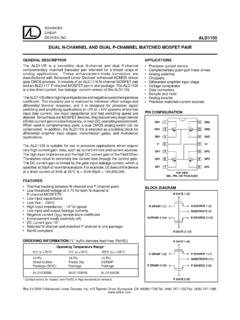Transcription of Problem of the Month: Perfect Pair - Inside Mathematics
1 Problem of the month Perfect Pair Silicon Valley Mathematics Initiative 2013. This work is licensed under a Creative Commons Attribution NonCommercial NoDerivatives Unported License ( nc ). Problem of the month : Perfect Pair The Problems of the month (POM) are used in a variety of ways to promote Problem solving and to foster the first standard of mathematical practice from the Common Core State Standards: Make sense of problems and persevere in solving them. The POM may be used by a teacher to promote Problem solving and to address the differentiated needs of her students. A department or grade level may engage their students in a POM to showcase Problem solving as a key aspect of doing Mathematics . It can also be used schoolwide to promote a Problem solving theme at a school.
2 The goal is for all students to have the experience of attacking and solving non routine problems and developing their mathematical reasoning skills. Although obtaining and justifying solutions to the problems is the objective, the process of learning to Problem solve is even more important. The Problem of the month is structured to provide reasonable tasks for all students in a school. The structure of a POM is a shallow floor and a high ceiling, so that all students can productively engage, struggle, and persevere. The Primary Version Level A is designed to be accessible to all students and especially the key challenge for grades K 1. Level A will be challenging for most second and third graders. Level B may be the limit of where fourth and fifth grade students have success and understanding.
3 Level C may stretch sixth and seventh grade students. Level D may challenge most eighth and ninth grade students, and Level E should be challenging for most high school students. These grade level expectations are just estimates and should not be used as an absolute minimum expectation or maximum limitation for students. Problem solving is a learned skill, and students may need many experiences to develop their reasoning skills, approaches, strategies, and the perseverance to be successful. The Problem of the month builds on sequential levels of understanding. All students should experience Level A and then move through the tasks in order to go as deeply as they can into the Problem . There will be those students who will not have access into even Level A.
4 Educators should feel free to modify the task to allow access at some level. Overview: In the Problem of the month Perfect Pair, students are engaged in tasks and puzzles that involve properties, equality, equations, and variables. The mathematical topics that underlie this POM are number properties, operations, number theory, equality, variables, identities, inverse operations, solving equations, generalizing, and algebraic thinking. In the first levels of the POM, students are presented with a task involving number sentences involving addition and subtraction using the same two numbers. The task Problem of the month Perfect Pair Silicon Valley Mathematics Initiative 2013. This work is licensed under a Creative Commons Attribution NonCommercial NoDerivatives Unported License ( nc ).
5 Involves finding the addition identity. In level B, students are presented with equations and unknown symbolized as different types of shoes. They need to determine which digit (0 9) corresponds to each style shoe. Students need to use their knowledge of the numbers and operations to deduce and solve the unknowns. In level C, students are presented with two different relationships of three unknowns and different operations. The students are asked to determine the sets of values for the unknowns that make the relationship equal. In level D, students are given a similar situation to the one they had in level B, but this time they have to determine values for when the sum of two numbers equals the product of the two numbers. The goal is to find the set of numbers that satisfy that relationship.
6 In the final level E, students are asked to consider when the sum of two numbers can equal the quotient of the same two numbers. The task is to find the generalization for all number pairs that satisfy the situation and characterize the set. Mathematical Concepts: Algebra is the cornerstone of secondary Mathematics . Algebraic thinking is taught in primary grades with the foundations of algebra taught usually by the end of middle school. Even though the term algebraic thinking is routinely used, it can not be simply defined. The underpinnings of algebra involve abstractions and language. There are several resources that define the most important concepts in algebra. One resource is Fostering Algebraic Thinking, by Mark Driscoll, published by Heinemann, 1999.
7 Problem of the month Perfect Pair Page 1 Silicon Valley Mathematics Initiative 2010. This work is licensed under a Creative Commons Attribution-NonCommercial-NoDerivatives Unported License ( ). Level A When you add two numbers you get a certain answer. Using the same two numbers, subtract the smaller from the larger number. If the two answers are the same, we will call that a Perfect pair. Can you find two numbers that are a Perfect pair? If you think it is impossible, explain why. If you have found a Perfect pair, explain why they are a Perfect pair. If it is possible, is there more than one Perfect pair? How many are there? Explain all you know about Perfect pairs and what is special about them. Problem of the month Perfect PairProblem of the month Perfect Pair Page 2 Silicon Valley Mathematics Initiative 2010.
8 This work is licensed under a Creative Commons Attribution-NonCommercial-NoDerivatives Unported License ( ). Level B Each shoe represents a digit (0, 1, 2, 3, 4, 5, 6, 7, 8, 9). The style of shoe always represents the same digit in all of the number sentences. Examine the number sentences. Pair each shoe with a digit. Explain your reasoning. = - = + + = x = x = - + = x = - = - = Problem of the month Perfect Pair Page 3 Silicon Valley Mathematics Initiative 2010. This work is licensed under a Creative Commons Attribution-NonCommercial-NoDerivatives Unported License ( ). Level C A Perfect trio involves three whole numbers. Using the three numbers, add the first two numbers together then divide the sum by the third number.
9 Using the same three numbers, subtract the second from the first number and then multiple the difference by the third. The trio is Perfect if the two outcomes are equal. Can you find three whole numbers that are Perfect trios? If not, how can you show that there are not any Perfect trios? Is there a way to prove there are no Perfect trios? Explain completely. If you can find a Perfect trio, is there more than one Perfect trio? If so, how many? List the trio(s) you found. How do you know if you found them all? Describe any special characteristics of Perfect trios. How can you go about finding them? Explain of the month Perfect Pair Page 4 Silicon Valley Mathematics Initiative 2010. This work is licensed under a Creative Commons Attribution-NonCommercial-NoDerivatives Unported License ( ).
10 Level D In this Problem , a Perfect pair is defined as two numbers whose sum is equal to their product. Explore these Perfect pairs. If you cannot find any Perfect pairs, prove that a Perfect pair cannot exist. If you find Perfect pairs, then generalize your findings and describe the relationship of the number pairs. Illustrate the set of Perfect pairs using multiple representations (words, symbols, graphs, tables, diagrams). Problem of the month Perfect Pair Page 5 Silicon Valley Mathematics Initiative 2010. This work is licensed under a Creative Commons Attribution-NonCommercial-NoDerivatives Unported License ( ). Level E In this Problem , a Perfect pair is defined as two numbers whose sum is equal to their quotient.


















